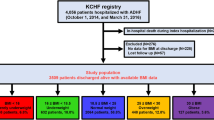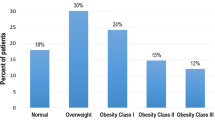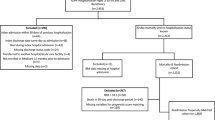Abstract
Several lines of evidence demonstrated body mass index (BMI) to be inversely associated with outcomes of patients with HF, so-called obesity paradox. However, the relationship between BMI and outcomes of patients with HF in Japan has been poorly understood. This study sought to explore the relationship between BMI and in-hospital mortality of patients hospitalized for heart failure (HF) in Japan and whether BMI at hospital admission could be used for the risk stratification of hospitalized HF patients. We studied 407,722 patients hospitalized for HF between January 2010 and March 2018, using the Diagnosis Procedure Combination database, a national inpatient database in Japan. Patients were categorized into four groups: underweight (BMI < 18.5 kg/m2), 66,342 patients (16.3%); normal (18.5–24.9 kg/m2), 240,801 patients (59.1%); pre-obesity (25.0–29.9 kg/m2), 76,954 patients (18.9%); and obesity (≥ 30.0 kg/m2), 23,625 patients (5.8%). Pre-obese and obese patients were younger and more likely to be male. Advanced HF symptoms were more common among underweight patients. Multivariable logistic regression analysis fitted with generalized estimating equation showed that, compared with normal weight patients underweight patients had higher in-hospital mortality (odds ratio 1.50, 95% confidence interval 1.45–1.55), whereas pre-obese patients (odds ratio 0.80, 95% confidence interval 0.77–0.83) and obese patients (odds ratio 0.90, 95% confidence interval 0.84–0.97) had lower in-hospital mortality. Restricted cubic spline showed a reverse J-shaped relationship between BMI and in-hospital mortality with the bottoms of splines around BMI 26 kg/m2. In conclusion, underweight patients had higher, and pre-obese and obese patients had lower in-hospital mortality compared to patients with normal weight patients. Furthermore, restricted cubic spline indicated a reverse J-shaped relationship between BMI and in-hospital mortality. Our findings are informative for the risk stratification of patients hospitalized for HF according to BMI.


Similar content being viewed by others
References
Calle EE, Thun MJ, Petrelli JM, Rodriguez C, Heath CW Jr (1999) Body-mass index and mortality in a prospective cohort of US adults. N Engl J Med 341:1097–1105
Kenchaiah S, Evans JC, Levy D, Wilson PW, Benjamin EJ, Larson MG, Kannel WB, Vasan RS (2002) Obesity and the risk of heart failure. N Engl J Med 347:305–313
Horwich TB, Fonarow GC, Hamilton MA, MacLellan WR, Woo MA, Tillisch JH (2001) The relationship between obesity and mortality in patients with heart failure. J Am Coll Cardiol 38:789–795
Kaneko H, Yajima J, Oikawa Y, Tanaka S, Fukamachi D, Suzuki S, Sagara K, Otsuka T, Matsuno S, Funada R, Kano H, Uejima T, Koike A, Nagashima K, Kirigaya H, Sawada H, Aizawa T, Yamashita T (2013) Obesity paradox in Japanese patients after percutaneous coronary intervention: an observation cohort study. J Cardiol 62:18–24
Moscarella E, Spitaleri G, Brugaletta S, Senti Farrarons S, Pernigotti A, Ortega-Paz L, Cequier A, Iniguez A, Serra A, Jimenez-Quevedo P, Mainar V, Campo G, Tespili M, den Heijer P, Bethencourt A, Vazquez N, Valgimigli M, Serruys PW, Sabate M (2017) Impact of body mass index on 5-year clinical outcomes in patients with ST-segment elevation myocardial infarction after everolimus-eluting or bare-metal stent implantation. Am J Cardiol 120:1460–1466
Lavie CJ, Osman AF, Milani RV, Mehra MR (2003) Body composition and prognosis in chronic systolic heart failure: the obesity paradox. Am J Cardiol 91:891–894
Curtis JP, Selter JG, Wang Y, Rathore SS, Jovin IS, Jadbabaie F, Kosiborod M, Portnay EL, Sokol SI, Bader F, Krumholz HM (2005) The obesity paradox: body mass index and outcomes in patients with heart failure. Arch Intern Med 165:55–61
Lavie CJ, Alpert MA, Arena R, Mehra MR, Milani RV, Ventura HO (2013) Impact of obesity and the obesity paradox on prevalence and prognosis in heart failure. JACC Heart Fail 1:93–102
Frankenstein L, Zugck C, Nelles M, Schellberg D, Katus HA, Remppis BA (2009) The obesity paradox in stable chronic heart failure does not persist after matching for indicators of disease severity and confounders. Eur J Heart Fail 11:1189–1194
Wu AH, Eagle KA, Montgomery DG, Kline-Rogers E, Hu YC, Aaronson KD (2009) Relation of body mass index to mortality after development of heart failure due to acute coronary syndrome. Am J Cardiol 103:1736–1740
Hamaguchi S, Tsuchihashi-Makaya M, Kinugawa S, Goto D, Yokota T, Goto K, Yamada S, Yokoshiki H, Takeshita A, Tsutsui H, Investigators J-C (2010) Body mass index is an independent predictor of long-term outcomes in patients hospitalized with heart failure in Japan. Circ J 74:2605–2611
Lin GM, Li YH, Yin WH, Wu YW, Chu PH, Wu CC, Hsu CH, Wen MS, Voon WC, Wang CC, Yeh SJ, Lin WS, Taiwan Society of Cardiology Heart Failure with Reduced Ejection Fraction registry i, committee (2016) The obesity-mortality paradox in patients with heart failure in Taiwan and a collaborative meta-analysis for east Asian patients. Am J Cardiol 118:1011–1018
Tagami T, Matsui H, Fushimi K, Yasunaga H (2016) Prophylactic antibiotics may improve outcome in patients with severe burns requiring mechanical ventilation: propensity score analysis of a Japanese Nationwide Database. Clin Infect Dis 62:60–66
Yagi M, Yasunaga H, Matsui H, Morita K, Fushimi K, Fujimoto M, Koyama T, Fujitani J (2017) Impact of rehabilitation on outcomes in patients with ischemic stroke: a nationwide retrospective cohort study in Japan. Stroke 48:740–746
Shigemi D, Isogai S, Uda K, Aso S, Matsui H, Fushimi K, Yasunaga H (2019) Association between rehabilitation during hospitalization and perinatal outcomes among pregnant women with threatened preterm birth. J Matern Fetal Neonatal Med. https://doi.org/10.1080/14767058.2019.1623197
Shakya S, Matsui H, Fushimi K, Yasunaga H (2017) In-hospital complications after implantation of cardiac implantable electronic devices: analysis of a national inpatient database in Japan. J Cardiol 70:405–410
Isogai T, Matsui H, Tanaka H, Fushimi K, Yasunaga H (2017) Seasonal variation in patient characteristics and in-hospital outcomes of Takotsubo syndrome: a nationwide retrospective cohort study in Japan. Heart Vessels 32:1271–1276
Kaneko H, Itoh H, Yotsumoto H, Kiriyama H, Kamon T, Fujiu K, Morita K, Michihata N, Jo T, Morita H, Yasunaga H, Komuro I (2020) Characteristics and outcomes of super-elderly patients (aged>=90 years) hospitalized for heart failure—analysis of a Nationwide Inpatient Database. Circ Rep 2:393–399
Kaneko H, Itoh H, Yotsumoto H, Kiriyama H, Kamon T, Fujiu K, Morita K, Michihata N, Jo T, Morita H, Yasunaga H, Komuro I (2020) Association between the number of hospital admissions and in-hospital outcomes in patients with heart failure. Hypertens Res. https://doi.org/10.1038/s41440-020-0505-2
Kaneko H, Itoh H, Yotsumoto H, Kiriyama H, Kamon T, Fujiu K, Morita K, Michihata N, Jo T, Takeda N, Morita H, Yasunaga H, Komuro I (2020) Association of cancer with outcomes in patients hospitalized for heart failure. Circ J. https://doi.org/10.1253/circj.CJ-20-0314
Nagai T, Iwakami N, Nakai M, Nishimura K, Sumita Y, Mizuno A, Tsutsui H, Ogawa H, Anzai T, Investigators J-D (2019) Effect of intravenous carperitide versus nitrates as first-line vasodilators on in-hospital outcomes in hospitalized patients with acute heart failure: Insight from a nationwide claim-based database. Int J Cardiol 280:104–109
Hanley JA, Negassa A, Edwardes MD, Forrester JE (2003) Statistical analysis of correlated data using generalized estimating equations: an orientation. Am J Epidemiol 157:364–375
Yasunaga H, Horiguchi H, Matsuda S, Fushimi K, Hashimoto H, Ayanian JZ (2013) Body mass index and outcomes following gastrointestinal cancer surgery in Japan. Br J Surg 100:1335–1343
Sakamoto T, Fujiogi M, Matsui H, Fushimi K, Yasunaga H (2019) Timing of cholecystectomy after percutaneous transhepatic gallbladder drainage for acute cholecystitis: a nationwide inpatient database study. HPB (Oxford) 22(6):920–926
Desquilbet L, Mariotti F (2010) Dose-response analyses using restricted cubic spline functions in public health research. Stat Med 29:1037–1057
Komuro I, Kaneko H, Morita H, Isobe M, Nakayama H, Minematsu K, Yamaguchi T, Yazaki Y (2019) Nationwide actions against heart failure pandemic in Japan—what should we do from academia? Circ J 83:1819–1821
Kenchaiah S, Pocock SJ, Wang D, Finn PV, Zornoff LA, Skali H, Pfeffer MA, Yusuf S, Swedberg K, Michelson EL, Granger CB, McMurray JJ, Solomon SD, Investigators C (2007) Body mass index and prognosis in patients with chronic heart failure: insights from the Candesartan in Heart failure: assessment of reduction in mortality and morbidity (CHARM) program. Circulation 116:627–636
Sasaki N, Lee J, Park S, Umegaki T, Kunisawa S, Otsubo T, Ikai H, Imanaka Y (2013) Development and validation of an acute heart failure-specific mortality predictive model based on administrative data. Can J Cardiol 29:1055–1061
Fonarow GC, Adams KF Jr, Abraham WT, Yancy CW, Boscardin WJ, Committee ASA, SG, Investigators, (2005) Risk stratification for in-hospital mortality in acutely decompensated heart failure: classification and regression tree analysis. JAMA 293:572–580
Meng FC, Li YH, Lin GM, Lin CS, Yang SP, Lin WH (2018) Association of preexisting hypertension with the morality in patients with systolic heart failure in Taiwan: the TSOC-HFrEF Registry. Indian Heart J 70:604–607
Fonarow GC, Abraham WT, Albert NM, Stough WG, Gheorghiade M, Greenberg BH, O'Connor CM, Nunez E, Yancy CW, Young JB (2008) A smoker's paradox in patients hospitalized for heart failure: findings from OPTIMIZE-HF. Eur Heart J 29:1983–1991
Doi SA, Islam N, Sulaiman K, Alsheikh-Ali AA, Singh R, Al-Qahtani A, Asaad N, AlHabib KF, Al-Zakwani I, Al-Jarallah M, AlMahmeed W, Bulbanat B, Bazargani N, Amin H, Al-Motarreb A, AlFaleh H, Panduranga P, Shehab A, Al Suwaidi J, Salam AM (2019) Demystifying smoker's paradox: a propensity score-weighted analysis in patients hospitalized with acute heart failure. J Am Heart Assoc 8:e013056
Yoshioka K, Matsue Y, Yamaguchi T, Kitai T, Kagiyama N, Okumura T, Kida K, Oishi S, Akiyama E, Suzuki S, Yamamoto M, Kuroda S, Matsumura A, Hirao K (2019) Safety and prognostic impact of early treatment with angiotensin-converting enzyme inhibitors or angiotensin receptor blockers in patients with acute heart failure. Am J Cardiovasc Drugs 19:597–605
Weber MA, Neutel JM, Smith DH (2001) Contrasting clinical properties and exercise responses in obese and lean hypertensive patients. J Am Coll Cardiol 37:169–174
Kaneko H, Suzuki S, Goto M, Yuzawa Y, Arita T, Yagi N, Murata N, Kato Y, Kano H, Matsuno S, Otsuka T, Uejima T, Takai H, Oikawa Y, Kunihara T, Nagashima K, Kirigaya H, Sagara K, Sawada H, Aizawa T, Yajima J, Yamashita T (2015) Geriatric nutritional risk index in hospitalized heart failure patients. Int J Cardiol 181:213–215
Anker SD, Coats AJ (1999) Cardiac cachexia: a syndrome with impaired survival and immune and neuroendocrine activation. Chest 115:836–847
Mustafa I, Leverve X (2001) Metabolic and nutritional disorders in cardiac cachexia. Nutrition 17:756–760
Maeda D, Kanzaki Y, Sakane K, Ito T, Sohmiya K, Hoshiga M (2020) Prognostic impact of a novel index of nutrition and inflammation for patients with acute decompensated heart failure. Heart Vessels 35:1201–1208
Dixon AE, Peters U (2018) The effect of obesity on lung function. Expert Rev Respir Med 12:755–767
Powell-Wiley TM, Ngwa J, Kebede S, Lu D, Schulte PJ, Bhatt DL, Yancy C, Fonarow GC, Albert MA (2018) Impact of body mass index on heart failure by race/ethnicity from the get with the guidelines-heart failure (GWTG-HF) Registry. JACC Heart Fail 6:233–242
Gallagher D, Heymsfield SB, Heo M, Jebb SA, Murgatroyd PR, Sakamoto Y (2000) Healthy percentage body fat ranges: an approach for developing guidelines based on body mass index. Am J Clin Nutr 72:694–701
WHO Expert Consultation (2004) Appropriate body-mass index for Asian populations and its implications for policy and intervention strategies. Lancet 363:157–163
Wang J, Thornton JC, Russell M, Burastero S, Heymsfield S, Pierson RN Jr (1994) Asians have lower body mass index (BMI) but higher percent body fat than do whites: comparisons of anthropometric measurements. Am J Clin Nutr 60:23–28
Karter AJ, Mayer-Davis EJ, Selby JV, D'Agostino RB Jr, Haffner SM, Sholinsky P, Bergman R, Saad MF, Hamman RF (1996) Insulin sensitivity and abdominal obesity in African–American, hispanic, and non-hispanic white men and women. The insulin resistance and atherosclerosis study. Diabetes 45:1547–1555
Lear SA, Humphries KH, Kohli S, Chockalingam A, Frohlich JJ, Birmingham CL (2007) Visceral adipose tissue accumulation differs according to ethnic background: results of the Multicultural Community Health Assessment Trial (M-CHAT). Am J Clin Nutr 86:353–359
Tsujimoto T, Kajio H (2017) Abdominal obesity is associated with an increased risk of all-cause mortality in patients with HFpEF. J Am Coll Cardiol 70:2739–2749
Chandramouli C, Tay WT, Bamadhaj NS, Tromp J, Teng TK, Yap JJL, MacDonald MR, Hung CL, Streng K, Naik A, Wander GS, Sawhney J, Ling LH, Richards AM, Anand I, Voors AA, Lam CSP, Investigators A-H (2019) Association of obesity with heart failure outcomes in 11 Asian regions: a cohort study. PLoS Med 16:e1002916
Lin GM, Li YH, Lin CL, Wang JH, Han CL (2013) Relation of body mass index to mortality among Asian patients with obstructive coronary artery disease during a 10-year follow-up: a report from the ET-CHD registry. Int J Cardiol 168:616–620
Li YH, Lin GM, Lin CL, Wang JH, Han CL (2013) Relation of body mass index to mortality among patients with percutaneous coronary intervention longer than 5 years follow-up: a meta-analysis. Int J Cardiol 168:4315–4318
Funding
This work was supported by grants from the Ministry of Health, Labour and Welfare, Japan (19AA2007 and H30-Policy-Designated-004) and the Ministry of Education, Culture, Sports, Science and Technology, Japan (17H04141).
Author information
Authors and Affiliations
Corresponding author
Ethics declarations
Conflict of interest
The authors have no conflicts of interest to declare for this study.
Ethical approval
Research funding and scholarship funds (Hidehiro Kaneko and Katsuhito Fujiu) from Medtronic Japan CO., LTD, Abbott Medical Japan CO., LTD, Boston Scientific Japan CO., LTD, and Fukuda Denshi, Central Tokyo CO., LTD.
Additional information
Publisher's Note
Springer Nature remains neutral with regard to jurisdictional claims in published maps and institutional affiliations.
Rights and permissions
About this article
Cite this article
Itoh, H., Kaneko, H., Kiriyama, H. et al. Reverse J-shaped relationship between body mass index and in-hospital mortality of patients hospitalized for heart failure in Japan. Heart Vessels 36, 383–392 (2021). https://doi.org/10.1007/s00380-020-01699-6
Received:
Accepted:
Published:
Issue Date:
DOI: https://doi.org/10.1007/s00380-020-01699-6




